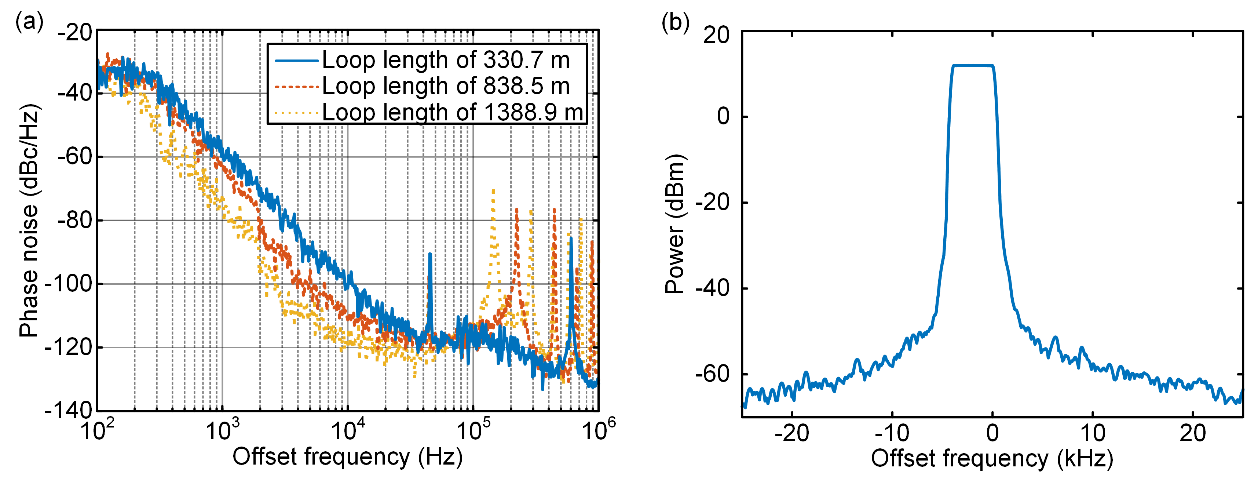High-quality microwave signals are the cornerstone of modern microwave systems, with widespread applications in civilian and defense sectors. Traditional electronic technologies still face significant challenges in generating high-frequency microwave signals with low-phase noise due to electronic limitations. Microwave photonics, leveraging the advantages of low-loss, wide bandwidth, and immunity to electromagnetic interference offered by photonics, provides a fresh perspective and robust support for the generation, processing, and transmission of high-quality microwave signals. Among them, the optoelectronic oscillator (OEO) is a photonic technology capable of generating high-frequency, low-phase-noise, and highly frequency-stable microwave signals, making it an ideal source for microwave signals.
Mode selection is key for OEO to generate high-purity microwave signal. Parity-time (PT) symmetry is demonstrated as an effective approach to mode selection. However, PT-symmetric OEOs based on spatial dual loops consist of two physically separated loops that require complete consistency in feedback loops, increasing system complexity and sensitivity to environmental disturbances. Therefore, constructing PTsymmetry in a single spatial loop can effectively simplify PT-symmetric systems.
Recently, Professor Xinliang Zhang and Associate Professor YuanYu'sgroupfromHuazhong University of Science and Technology(HUST) proposed to realize a PT-symmetric with single physical loop based on the stimulated Brillouin scattering (SBS) effect. The SBS gain and SBS loss are used to construct the gain loop and loss loop of PT symmetry, respectively. Meanwhile, the narrowband transmission of SBS is also used for mode selection. Therefore, by combining the narrow passband microwave photonic filter and PT symmetry, the OEO mode selection can be significantly enhanced. Notably, the SBS gain and loss occur in a single physical loop. Therefore, the system is significantly simplified compared with previously reported dual-loop structures and system stability is also improved. This research, entitled Parity–time-symmetric optoelectronic oscillator based on stimulated Brillouin scattering, is published in ACS Photonics in 2023, volumn10, issue7.

Fig. 1. Experimental setup of PT-symmetric OEO based on SBS.

Fig. 2. Measured results when the loop length is 1388.9 m. (a) Multi-mode oscillation spectrum, Inset: Zoomed-in view with a span of 700 kHz and a resolution of 6.8 kHz; (b) Single-mode oscillation spectrum, Inset: Zoomed-in view with a span of 2 MHz and a resolution of 18 kHz; (c) Comparison of single-mode and multi-mode oscillation spectra with a span of 0.4 MHz and a resolution of 3.9 kHz.
Figure 1 illustrates the experimental setup of a PT-symmetric OEO based on SBS. When the pump and probe lights have the same wavelength, SBS gain and SBS loss can amplify and attenuate the -1storder and the +1stordersidebands, respectively, thus forming the gain and loss in PT symmetry. In the experiment, stable single-mode oscillation is achieved by adjusting the pump light power and SBS efficiency to match the gain and loss. When PT symmetry is not satisfied, the OEO operates in a multi-mode oscillation state, as shown in Figure 2(a). A zoomed-in view of the multi-mode oscillation spectrum shows that the mode spacing is 144 kHz, corresponding to a loop length of 1388.9 m. By adjusting the gain and loss through polarization control of the probe and pump light, stable single-mode oscillation is achieved, as shown in Fig. 2(b). Single-mode oscillation is observed and the oscillation frequency is 9.66 GHz.The sideband suppression ratio of the oscillation signal is 41 dB. To show the effectiveness of PT symmetry, the electrical spectra of multi-mode oscillation and single-mode oscillation are compared in Figure 2(c). When operating in single mode, the oscillation signal power increases by 2.74 dB, and the left and right sidemodes are suppressed by 33.42 dB and 34.55 dB, respectively.

Fig. 3. (a) Measured phase noise of the PT-symmetric OEO based on SBS Effect with different loop lengths; (b) Measured frequency drift within 1 minute.
To evaluate the quality of the microwave signals generated by the OEO, phase noise and frequency stability of the microwave signals are measured, as shown in Figure 3. Figure 3(a) shows the phase noise of the generated microwave signals with different loop lengths. When the loop length is 1388.9m, the phase noise at 10 kHz offset is -120.1 dBc/Hz, and the side mode noise is lower than -70 dBc/Hz. Figure 3(b) shows the frequency drifts within 3.84 kHz within one minute. No mode hopping or significant power fluctuations occurred, indicating excellent stability of generated microwave signals in this scheme.
This work has important applications in radar, wireless communication, and electronic warfare. The research is supported by the National Key R&D Program, the National Natural Science Foundation, and the Academic Frontier Youth Team Research Project at Huazhong University of Science and Technology.
(https://doi.org/10.1021/acsphotonics.2c01518)